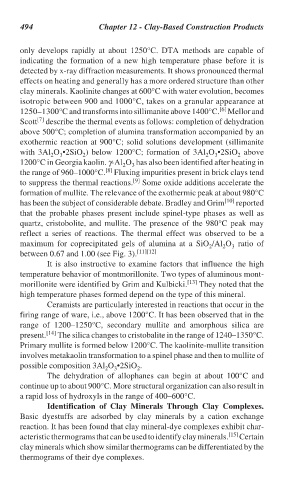Page 523 - Handbook of Thermal Analysis of Construction Materials
P. 523
494 Chapter 12 - Clay-Based Construction Products
only develops rapidly at about 1250°C. DTA methods are capable of
indicating the formation of a new high temperature phase before it is
detected by x-ray diffraction measurements. It shows pronounced thermal
effects on heating and generally has a more ordered structure than other
clay minerals. Kaolinite changes at 600°C with water evolution, becomes
isotropic between 900 and 1000°C, takes on a granular appearance at
[6]
1250–1300°C and transforms into sillimanite above 1400°C. Mellor and
[7]
Scott describe the thermal events as follows: completion of dehydration
above 500°C; completion of alumina transformation accompanied by an
exothermic reaction at 900°C; solid solutions development (sillimanite
with 3Al O •2SiO ) below 1200°C; formation of 3Al O •2SiO above
3
2
2
3
2
2
1200°C in Georgia kaolin. γ-Al O has also been identified after heating in
2 3
[8]
the range of 960–1000°C. Fluxing impurities present in brick clays tend
[9]
to suppress the thermal reactions. Some oxide additions accelerate the
formation of mullite. The relevance of the exothermic peak at about 980°C
has been the subject of considerable debate. Bradley and Grim [10] reported
that the probable phases present include spinel-type phases as well as
quartz, cristobolite, and mullite. The presence of the 980°C peak may
reflect a series of reactions. The thermal effect was observed to be a
maximum for coprecipitated gels of alumina at a SiO /Al O ratio of
2 2 3
between 0.67 and 1.00 (see Fig. 3). [11][12]
It is also instructive to examine factors that influence the high
temperature behavior of montmorillonite. Two types of aluminous mont-
morillonite were identified by Grim and Kulbicki. [13] They noted that the
high temperature phases formed depend on the type of this mineral.
Ceramists are particularly interested in reactions that occur in the
firing range of ware, i.e., above 1200°C. It has been observed that in the
range of 1200–1250°C, secondary mullite and amorphous silica are
present. [14] The silica changes to cristobalite in the range of 1240–1350°C.
Primary mullite is formed below 1200°C. The kaolinite-mullite transition
involves metakaolin transformation to a spinel phase and then to mullite of
possible composition 3Al O •2SiO .
2
3
2
The dehydration of allophanes can begin at about 100°C and
continue up to about 900°C. More structural organization can also result in
a rapid loss of hydroxyls in the range of 400–600°C.
Identification of Clay Minerals Through Clay Complexes.
Basic dyestuffs are adsorbed by clay minerals by a cation exchange
reaction. It has been found that clay mineral-dye complexes exhibit char-
acteristic thermograms that can be used to identify clay minerals. [15] Certain
clay minerals which show similar thermograms can be differentiated by the
thermograms of their dye complexes.

